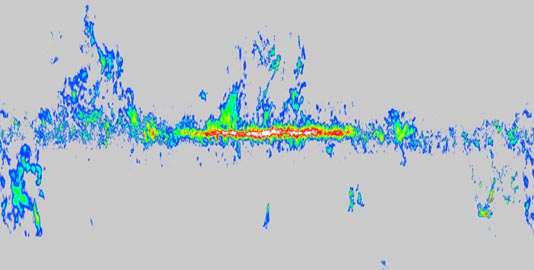Credit & Copyright: T. Dame
(CfA, Harvard) et al.,
Columbia 1.2-m Radio Telescopes
Explanation:
Where are the Milky Way's gas clouds and where are they going?
Stars form in gas clouds,
and the motion of gas clouds tell us about the
size and rotation speed of our own
Milky Way Galaxy.
But gas clouds are hard to detect - they are
composed mostly of nearly invisible molecular
hydrogen and
helium.
Fortunately, at least small amounts of heavier gases co-exist, one of them being
carbon monoxide (CO),
which is relatively easy to detect at radio wavelengths.
Therefore, over the past decade, a
team of astronomers
have
carefully
mapped out the molecular sky to unprecedented
clarity - to about four times previous resolution
and about eight times previous sensitivity. The resulting
map is shown above,
rescaled and in false color, with dark blue
being relatively low emission. The band of our
Milky Way Galaxy
spans the middle. The data have not only helped our understanding of the
Galaxy,
but highlight a few mysteries too. For example:
what
causes the rapid speed of the gas near the
Galactic Center?
Authors & editors:
Robert Nemiroff
(MTU) &
Jerry Bonnell
(USRA)
NASA Web Site Statements, Warnings,
and Disclaimers
NASA Official: Jay Norris.
Specific
rights apply.
A service of:
LHEA at
NASA /
GSFC
& Michigan Tech. U.
Based on Astronomy Picture
Of the Day
